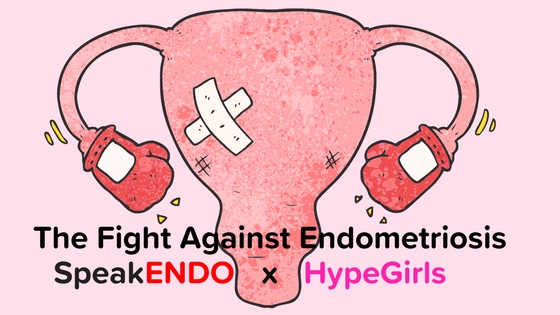FEATURESFeminine HealthInterviewsSelf Care
WTF is Endometriosis and Why Am I Just Hearing About It?
SpeakENDO Gynecologist Dr. Brotherton gives us the 411 on Endometriosis

Endometriosis occurs when tissue that behaves like the lining of your uterus begins to grow on the outside of your uterus. This tissue is called endometrium. Endometriosis is painful and many times can feel like severe cramping. Although, it’s may seem like this disease came out of thin air it’s quite common.
So what’s the hype? Why is it now becoming a prevalent topic?
Women are speaking up! It’s a beautiful thing when women stand in solidarity to celebrate their bodies and speak up about their tribulations. SpeakENDO has become the go-to resource for endometriosis, creating a safe space to speak up and study up on the disease.
SpeakENDO informs women of all walks of life of the symptoms, treatment options and even prepare for the talk with your gynecologist, allowing you to feel confident about the care you receive.
Endometriosis got you puzzled?
Us too. We had plenty of questions for you mama’s and we got answers. We were fortunate to pick the brilliant brain of Dr. Joy Brotherton.
Dr. Brotherton is an Obgyn, she is one of 29 doctors at Harbor-UCLA Medical Center, who specializes in obstetrics and gynecology. Her areas of expertise include endometriosis and hereditary breast cancer.
How common is Endometriosis?
Endometriosis is a chronic and painful disease that affects an estimated one in 10 women of reproductive age.
How does the diet change the pain level?
We know that endometriosis is an inflammatory disease fueled by estrogen. Therefore, it would make sense that limiting or eliminating foods that increase inflammation and estrogen in the body could potentially help with endometriosis-related pain.
A lot of dairy and meat products produced in the U.S. contain hormones. Soy products are also known to increase estrogen levels. Many processed foods, sugar, and alcohol are thought to increase inflammation in the body. It makes sense that a whole foods diet, high in plant-based foods, would be beneficial.
Also, we know that women who are overweight and obese have higher estrogen levels in general, and estrogen is the hormone we know stimulates endometriosis. Therefore, women should strive to keep a healthy weight.
Exercise is important for general life, is there a direct correlation between yoga and endometriosis pain?
I feel qualified to answer this question not because I am a surgeon who treats women with endometriosis but because I am currently completing a 200-hour yoga teacher training.
Yoga is a space to practice mindfulness and a space for us to (among other things) explore how to calm our nervous system. The movement and breath work exercises done in yoga are one way to help alleviate psychological stress. Much of modern day stress is psychologically derived and therefore has nowhere to be released. Instead it gets recycled back into the body as anxiety, tension, pain, and can contribute to many diseases.
Understanding this concept, many women with endometriosis live in fear of being in pain. Many experience depression and anxiety. Yoga can serve to help calm that response and turn on the parasympathetic (resting) system. If a woman with endometriosis is in pain, or fearful that she will have pain, I strongly believe that yoga and mindful breathing practices can help calm the pain response.
Why do you think women just recently began the conversation about being affected by this disease?
Despite being one of the most common gynecologic disorders in America, there is a lack of awareness and prioritization of endometriosis as an important women’s health issue. Efforts like SpeakENDO have helped to offer the latest information about endometriosis, true stories about women living with endometriosis and resources to help women have a better conversation with their healthcare provider.
I think we are seeing that women are ready to speak up and advocate for ourselves. Women are finding their voices and courage to speak out about injustices. I think it is an injustice that more attention has not been paid to this disease. Women have started the conversation around endometriosis and we will keep it going. I believe we will take care of each other!
How often is surgery needed for treatment?
Every woman is different. Surgery is one treatment option, but what’s really important is understanding your symptoms and speaking with your doctor to discuss a treatment approach that could work for you.
Endometriosis is different for every woman but some key things that I think are important when it comes to endometriosis: 1) women with endometriosis may be on many different treatments over their lifetime, 2) it is important to find a doctor that you can work with long term, as endometriosis is a chronic disease that can come back even after it is removed surgically, 3) we want to limit the number of surgeries a woman will have in her lifetime, and 4) women with endometriosis should work with their healthcare provider to create a “reproductive life plan,” which includes, among other things, discussing when would be a good time to become pregnant. While not all women with endometriosis will have problems getting pregnant, some may, so it is important for women with endometriosis to keep that in mind and be proactive about seeking help early.
Are there different surgical procedures that can be decided on?
The type of surgery ranges from excising just the endometriosis lesions and/or removing ovarian cysts, to removing one or both entire ovaries, to removing the entire uterus. Some women even require removal of a part of their colon in severe cases.
The mode of surgery can differ as well. The American Association of Gynecologic Laparoscopists (The AAGL) is an international society of surgeons dedicated to advancing minimally invasive surgical approaches, meaning performing these surgeries through small incisions, either laparoscopically or robotically, as opposed to through large incisions.
I recommend women seek out a high volume surgeon (a surgeon who does a lot of surgery) and who works with a lot of endometriosis patients. Ultimately it is important for each woman to work with her doctor to decide on the right option for her.
What is the average recovery time after surgery?
Recovery time depends on the type and mode of surgery and the extent of the disease. In general, recovery time from a minimally invasive surgery done through small incisions is much shorter than surgery done through a large incision. A less extensive surgery, say excision of endometriosis lesions, vs. a more extensive surgery, like removing a portion of the colon, will also have a faster recovery time. Again, it is not one-size-fits-all as each woman is different.
How does endometriosis affect pregnancy?
While women with endometriosis experience a variety of symptoms, women who have trouble getting pregnant may also have endometriosis. In fact, studies suggested that about 25% to 50% of infertile women also have endometriosis. That is why it is important for women with endometriosis to be proactive about seeking help if they are having trouble getting pregnant.
On the other hand, not all women with endometriosis will have trouble getting pregnant. It is just important for them to know it could be an issue and, if so, help is available.
What medicines are required for treatment? How do they work?
There is no known cure for endometriosis, but there are several medications available. It’s important for women to be specific about their symptoms when speaking to a healthcare provider, which can be helpful in creating a treatment plan.
Medication for endometriosis aim to lower or even out estrogen levels (estrogen fuels endometriosis) and lower inflammation (as endometriosis is also an inflammatory disease). Since many women experience worse symptoms during their period, medications aimed at stopping menstruation are often used. Anti-inflammatory medications are also often used to help with the inflammation.
Women with endometriosis who suffer significant pain and sometimes given strong narcotic medication for that pain. I believe that is is important to work with your doctor to find alternatives to long-term opioid use, which can become addicting and ultimately lead to other problems.
How could endometriosis affect your sex life?
Women with endometriosis can experience a variety of symptoms, including pain with intercourse. If a women feels pain during sex, she is likely not going to want to have sex. This can often lead to strain on a relationship. It is important for women with endometriosis to be open with their partners about their symptoms and help to educate them about their disease.
Are there any known natural ways to handle the pain or treatments?
When it comes to endometriosis pain relief, I think there are several things that many women may find beneficial. A simple hot water bottle placed on the lower abdomen or Epsom salt bath may provide symptomatic relief. Deep breathing exercises including alternate nostril breathing as taught in many yoga classes can help induce relaxation when a woman is anxious from the pain. Acupuncture is often recommended for help with pain reduction. Also, T.E.N.S. (Transcutaneous Electrical Nerve Stimulation), which are small battery powered electrodes that can be applied to the abdomen, are thought to help with pelvic pain.
There are several herbal medications used by homeopathic and Chinese herbal medication practitioners that exist, but have not necessarily been studied in a Western medicine sense. Regular exercise and a healthy diet of whole foods are important too, as mentioned earlier.
How often should you see your doctor?
It depends on the extent of symptoms, the state and stability of the disease, and where a woman is in her treatment plan. This is why it is of utmost importance for a woman to find a doctor that she can work with long term. At times, she may need to see her doctor more frequently. Other times, she may be able to space out her visits. It is so variable and each woman and her disease is different.
I would say at minimum, a women with endometriosis should to see her doctor at least once a year, if not twice. If she is having new issues or increased pain, she may need to see her doctor more frequently.





